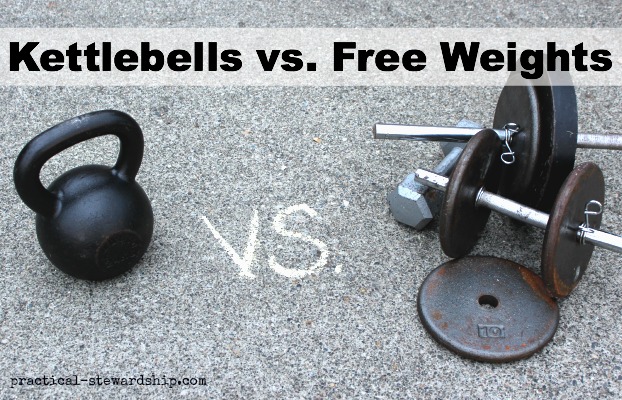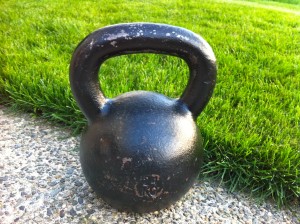
For the last couple of years, I have not been training with barbells. Rather, my equipment has included a scant six kettlebells and a pull-up bar. (In case you’re curious, I have two of each: 40#, 53# and 70#). On very rare occasions, I’ll put my hand on a basketball for some pushups or something, but I do kettlebell and bodyweight (calisthenic) training almost exclusively. And I am better conditioned and stronger than I was when I stopped including barbells in my regimen.

To be clear, I have nothing at all against barbell training. I like them a lot. I have some weights in storage for some day when we have a bigger place and I can set them up permanently. Barbell training totally has its place. But, as I’ve preached before, training decisions must be influenced by personal goals. And most people that I talk to are interested in getting in “better shape,” or losing some weight, or training for a stronger heart, or who would like to be mobile enough to play with their grandkids (now, for some, or when grandkids actually enter the picture, for others). And kettlebells render barbells and dumbbells completely unnecessary for the attaining of these goals.
So, if your goal is to become a bodybuilder or an underwear model, join a gym or spend $1000 on a decent set of free weights. Have fun. You’ll probably become healthier in the process. But if you are a part of the other 99% of folks whose goals are more like what I mentioned above, read on.
As the title would suggest, I’m going to argue that kettlebells are better than barbells, and I’ll start by talking about Utility.
In an effort to be succinct and clear, I have speak in general terms, and I won’t take time for all of the qualifiers and disclaimers to assuage the barbell purists out there. I speak from my own experience as a former CrossFitter and as a friendly critic of P90X. I appreciate both programs, but certainly don’t recommend them for everyone.
But generally speaking, metabolic conditioning involving high-repetition interval training is very, very effective for fat loss and conditioning. And olympic lifts (e.g., barbell snatches, deadlifts, squats) have no business being done for speed at high reps and for speed, as is often the case with CrossFit. This invites injuries like a fruit flies to a brown banana. However, the Kettlebell Snatch and the Swing are ballistic exercises patterned after their barbell cousins (barbell snatch and deadlift, respectively) and are intended to be done for multiple reps without rest. Each rep goes right into the next smoothly. So high rep training of olympic variations is effective and safer with a kettlebell than with barbells.
Further, most KB movements don’t involve taking a step, and most of my best cardio workouts – whether CrossFit or otherwise – have not involved running or jumping. Doing 200 Kettlebell Swings for time will get your heart screaming and challenge your grip, and it’s a whole lot safer than doing 200 deadlifts for time. Though deadlifts may be the greatest single exercise in the world, doing them quickly is a bad idea.
What’s more, I’ve found KB’s to be easier on the joints. If you want an example of the what I’m talking about, consider a military press with a kettlebell and a dumbbell. The round contour of the KB lends itself to a range of motion more consistent with the natural path of the arm. If you hold your fists close to your chest as though your guarding your body from a punch, that looks like the “rack” position in KB training. Then, if you were to “punch” straight up, the path of your arm will look very similar to the proper motion of a kettlebell press. Try this with a dumbbell in your hand and you’ll whack yourself in the face or shoulder. If you don’t believe me, try it out and you’ll see what I mean.
For slow lifts and grinds, barbells are great for building strength. But so are kettlebells. If you think you can’t get really strong using kettlebells, just try pressing a 48kg (106#) kettlebell for five reps. Or do ten front squats with a pair of 2-pood (70#) bells, and see how easy it can be (insert sinister cackle here). Besides, anyone who has done it can tell you that bench pressing two 50# dumbbells is way harder than bench pressing 100# with a barbell. Those dumbbells are wanting to move all over the place, and pressing them requires activating the small, stabilizing muscles that surround the big, powerful ones. Well, those smaller muscles are always active when training with kettlebells.
For me, doing front squats with a pair of 53# bells requires similar exertion to front squatting about 150# on a bar. But it’s harder, and more physically demanding. It just works more parts of the body. (And it requires none of the setup!)
So while you cannot do everything with kettlebells that you can with barbells, I believe you can do far more with kettlebells than you can with barbells. So – unless you want to be a bodybuilder or a linebacker (and leg press 800#) – why would you choose barbells over kettlebells?
Maybe this resonates with you. If not, you’re free to disagree or set me straight in the comments section below. Check back here soon for two more areas where kettlebells whoop up on barbells.
Happy training!
Jonathan
Other Fitness posts from PS.C:
Three Weeks with the “Armor Building” Complex My Four-Week Summer Program
